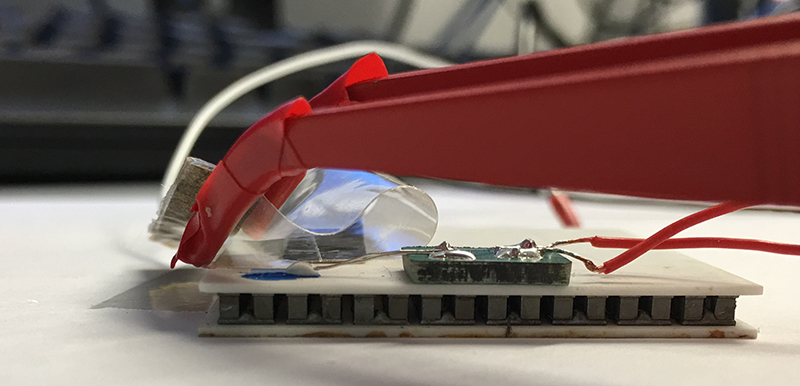Temperature sensor for artificial skin
The capacity to detect temperature changes is an important function of the human skin. Researchers at ETH Zurich have now developed a highly sensitive and, at the same time, flexible temperature sensor, which could soon be used in prosthetic limbs and robotic arms.

Rattlesnakes and pit-vipers are famous for being able to safely locate their prey even in absolute darkness. The highly sensitive pit organ between eye and nose allows them to detect the warm body of a mammal even at a meter’s distance. The exact working principle of these temperature sensors was only discovered a few years ago.
Scientists working with Chiara Daraio at the Department of Mechanical and Process Engineering at ETH Zurich have now succeeded in building an artificial temperature sensor based on natural substances that is just as sensitive and that could, thanks to its flexibility and other useful properties, soon be used as part of an artificial skin in prosthetic limbs or robotic arms.
Discovery through “cyberwood”
Serendipity played an important role in the discovery of this temperature sensor. In his research, Raffaele Di Giacomo, who led the project in the laboratory of ETH-professor Daraio, had initially stumbled upon a peculiarity of the vegetable material pectin. Pectin is better known around the household as a gelling agent for puddings and marmalades, but Di Giacomo was interested in a different property of this substance, which is composed of many interconnected sugar molecules.
Experiments on tree branches, whose cell walls contain pectin, had shown that their electrical conductivity depended strongly on temperature. To investigate the mechanism behind that dependence, the researchers in Zurich created an artificial “cyberwood” made from pectin and carbon nanotubes (see ETH-News from 31 March 2015).
By measuring the electrical resistance at different temperatures they eventually found that calcium ions trapped at the contact points between two sugar molecules were responsible for the sensing mechanism. The higher the temperature, the more free calcium ions were present in the artificial wood, and hence the better it conducted electrical current.
A thin film of pectin
“In this way we had found an ideal material for making a highly sensitive temperature sensor,” recalls Di Giacomo, “but it was as stiff as wood and hence rather unsuitable for use in an artificial skin”. The breakthrough came when Di Giacomo, together with doctoral student Luca Bonanomi, instead of the artificial wood produced a thin film of only 100 micrometers from a simple pectin gel laced with calcium solution.
At two ends of the film the researchers attached electrodes that allowed them to measure the electrical conductivity. The result: even the simple pectin film conducted electrical current more easily with increasing temperature. Moreover, it was wafer-thin, transparent and could be bent and deformed almost arbitrarily.
As sensitive as a snake
More precise measurements revealed that the scientists at ETH had found a temperature sensor that could actually match the performance of the highly sensitive pit organ found in snakes. From 10 to 50 degrees Celsius the pectin film can measure temperatures with a precision of a hundredth of a degree. That is comparable to the sensitivity of the pit organ and twice as sensitive as human skin.
“What’s more, our pectin film is extremely easy to make”, adds Di Giacomo, “and it contains no transistors or other electronic components. That means it’s far more robust and less prone to interference than existing flexible temperature sensors.”
Spatial resolution
In order to be suitable for use in prosthetic limbs, the pectin film also has to work when it is not laid out flat on a surface, but rather strongly bent. The temperature sensitive film passed that test with flying colours. Moreover, it should be possible to localize a temperature variation at a specific position on a larger film – similarly to the human skin, which can spatially resolve a hot or cold sensation.
To test this, the researchers attached several electrodes along the short and long sides of a film measuring 25 square centimetres that divided the film into a virtual grid. When the film a human finger touched the film at a certain position, from the variation in the signals of the various electrodes the researchers we able to determine the position of the finger rather accurately.
“We are now improving the computer algorithms used for analyzing the electrode signals”, explains former Master’s student Vincenzo Costanza, who co-authored the paper. Together with an improvement of the electrical contacts the temperature sensor should soon be ready for a field trial in robotics or prosthetics.
Reference
Di Giacomo R, Bonanomi L, Costanza V, Maresca B, Daraio C: Biomimetic temperature sensing layer for artificial skins, Science Robotics 2017, 2: eaai9251, doi: external page10.1126/scirobotics.aai9251call_made
